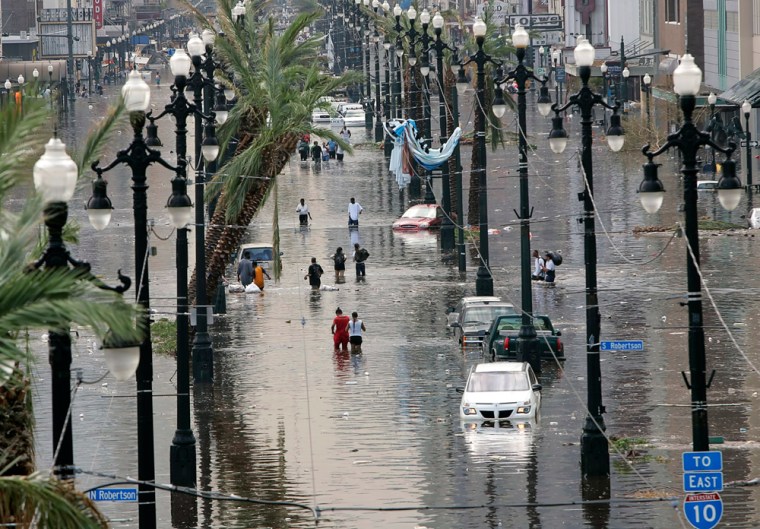With rescue operations in New Orleans focused on saving lives and restoring order in the hurricane battered city, little effort has been made so far to catalog the damage to the city’s considerable historic and cultural landmarks.
The hurricane and subsequent flooding damaged historical landmarks and wiped away at least some of the precious remnants of Louisiana’s time under French rule. But officials say many of the buildings that make up one of the most culturally influential cities in America appear to have survived intact, leaving them hopeful that restoration would be possible.
“There has not been a concerted effort or assessment of the damage to historic and cultural sites that I know of,” says John Hildreth, chief of the southern region for the National Trust for Historic Preservation. “I have seen some reports but it is scattered sketchy information on particular institutions. It’s all just kind of sketchy right now. The human element is just the priority right now.”
With no official accounting yet available, the best those charged with assessing such things could do is to study satellite photos of the city and rely on eyewitness accounts and bloggers for their information.
The American Association of Museums, for instance, has compiled a detailed rundown for New Orleans and the nearby Gulf region on their website, listing individual cultural institutions and providing the best sourcing and information they can muster on the fate of their collections, staff and structures.
A typical excerpt, this one focusing on the Louisiana State Museum in the French Quarter, reads: “Tamra Carboni, Director of Curatorial Services, called to say that some museum staff have visited the Jackson Square area in the French Quarter where the Cabildo, the Presbytere, and the Old Mint are located. The buildings sustained some damage but the collections are in better shape than feared. … Carolyn Harrington, director of the Louisiana State Museum's Old Court House Museum in Natchitoches, reported that the artifacts in New Orleans are safe except for some of the jazz collection in the Old Mint building. The staff is in the process of moving these collections now.”
But other landmarks have not fared as well. New Orleans media reports say that serious damage was suffered by some of the city’s famous restaurants, including Antoine’s and Commander’s Palace.
The U.S. Mint, an early nineteenth century building converted into a museum in the 1980s, suffered damage to its roof. Significant water damage also is reported to the Degas House, used as a studio by the French impressionist painter Edgar Degas in the early 1870s.
The 1734 Ursuline Convent, also in the Quarter, is believed to be the oldest building in the state of Louisiana. It suffered water damage but was standing.
New Orleans is dotted with landmarks like Preservation Hall, the font of American jazz music and a haunt of Louis Armstrong and other giants, and Tipitina’s, a newer venue that launched the careers of artists like the Neville Brothers and Dr. John.
"The thought of Tipitina's or Preservation Hall underwater is just horrific," says Scott Aiges, the city's music industry liaison and a former jazz writer for the Times-Picayune. "They are just irreplaceable."
The extent of the human tragedy and the ongoing threat of disease and violent crime has overwhelmed the region’s ability to respond or even catalog such damage. However, Aiges and others fears that these places, if not actually destroyed, lay open to plunder.
There is good news, however. City officials have said that the Saint Louis Cathedral, built in 1794, does not appear to have sustained major damage. The Garden District and some important parts of the French Quarter, too, were spared the worst because of their elevation relative to other neighborhoods. Reports suggest that the city's zoo and many of its museums also survived with limited damage.
“The older neighborhoods were build on higher ground, at least in New Orleans,” Hildreth says.
Still, with looters roaming the streets, cultural experts were hoping that some security could be provided.
“We are concerned about looting,” Hildreth said, noting that in neighboring Mississippi, the homestead of Confederate President Jefferson Davis, known as Beauvior, was completely destroyed and there was some concern about artifacts being looted.
He said the Federal Emergency Management Agency (FEMA), already straining to save lives and provide shelter for victims, also has activated a program designed to assess and protect cultural heritage sites.
The city has always stood apart from the rest of the American South, in its French roots, its Roman Catholic faith, its spicy cooking and notorious tolerance for debauchery.
Aiges, a northerner, moved to New Orleans in the late 1980s, drawn by the music scene. He later ran a record label and ultimately wound up running the city’s thriving music industry outreach program. But like many whose livelihood depend on New Orleans' vibrant cultural scene, he’s not sure he and his family will have a home to come back to, or a job, either.
“For now, we’re heading north to my parents in Long Island,” he said by cell phone in Nashville. “Our plan is to stay a month or so, kind of refugees, I guess, then to reassess. I just don’t know if there will be anything to go back to.”
